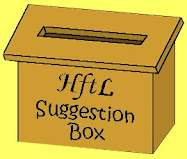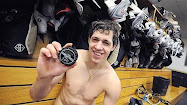
First of all, as we know, every game and every period starts with a face-off at centre ice. This is the only time you will see the senior referee drop the puck. Every other face-off during the course of the game will be orchestrated by one of the linesmen. The linesman controls the timing of the drop while, at the same time, trying to assure the face-off is fair to both players involved and that is the key. The face-off should be fair to both players and there are very specific rules regarding how a player taking a face-off must conduct himself as well as how the other players line up.
Some of the rules governing face-offs have changed in the last year, but these rules have remained the same:
When the faceoff takes place in any of the end face-off circles, the players taking part shall take their position so that they will stand squarely facing their opponent's end of the rink and clear of the ice markings. The sticks of both players facing-off shall have the blade on the ice within the designated white area. The visiting player shall place his stick within the designated white area first followed IMMEDIATELY by the home player.
However, no player is above cheating to win a face-off, and there is no shame in that. The two things players do most to get an edge are in how and when they put their sticks down and how they position their feet.
The visiting player is supposed to put his stick down first; yet, if you watch Sidney Crosby, he will put his stick down first even when playing at home. Does this work to the other players advantage? Not necessarily. You can actually have the advantage if you can put the stick down and bring it back up again all in one motion. This is because the player with his stick up has the advantage in leverage and can either hit the puck itself or use his stick to knock the other player's stick out of the way.
Another way a player might cheat is by how he positions his feet. While the rule says the player must be standing squarely on the marks or, if at the face-off spots in the neutral zone, squarely facing his opponent, you will rarely see this happen. Players will angle their feet to give themselves the advantage in leverage. Which way they angle their feet will depend on where the face-off is taking place (defensive vs. offensive zone), whether he is pulling the puck back or sweeping it to the side or pushing it forward and by which of his hands is dominant.
 But how does a linesman decide when to kick a player out of the face-off? Well, if the linesman feels that a player is blatantly cheating, he can order him out of the circle. When this happens, any team-mate (with the exception of the goalie per rule 76.1) may move into the circle to take the face-off. You will rarely see a defenseman take a face-off but it is not against the rules. During particularly important face-offs, such as in the defensive zone when protecting a one-goal lead, a coach may opt to put two centres on the ice so that if one gets dismissed, there is another "specialist" available to move in and take the face-off (why only centres generally are trained to take face-offs makes no sense to me - when I coached all my players practiced taking face-offs). Now, the decision that a player is cheating is really pretty arbitrary. Yes, there are rules governing the player in the face-off situation but, as anyone who watches face-offs pretty closely (or even not so closely) it looks like the linesmen could spend a LOT of time kicking people out.
But how does a linesman decide when to kick a player out of the face-off? Well, if the linesman feels that a player is blatantly cheating, he can order him out of the circle. When this happens, any team-mate (with the exception of the goalie per rule 76.1) may move into the circle to take the face-off. You will rarely see a defenseman take a face-off but it is not against the rules. During particularly important face-offs, such as in the defensive zone when protecting a one-goal lead, a coach may opt to put two centres on the ice so that if one gets dismissed, there is another "specialist" available to move in and take the face-off (why only centres generally are trained to take face-offs makes no sense to me - when I coached all my players practiced taking face-offs). Now, the decision that a player is cheating is really pretty arbitrary. Yes, there are rules governing the player in the face-off situation but, as anyone who watches face-offs pretty closely (or even not so closely) it looks like the linesmen could spend a LOT of time kicking people out.
Timing:
As soon as the line change procedure has been completed by the Referee and he lowers his hand to indicate no further changes, the Linesman conducting the face-off shall blow his whistle. This will signal to both teams that they have no more than five (5) seconds to line up for the ensuing face-off. At the end of the five (5) seconds (or sooner if both centers are ready), the Linesman is supposed to drop the puck unless:
- One or both centers are not positioned for the face-off
- One or both centers refrain from placing their stick on the ice (yeah, right - that's why Max Talbot got left looking stupid during a faceoff when the linesman dropped the puck when Max had his back turned as he was telling the other players where to stand),
- Any player has encroached into the face-off circle (obviously this rule is one that is pretty much ignored),
- Any player makes physical contact with an opponent, or
- Any player is in an off-side position
In the last two minutes of regulation time or any time in overtime, the linesman will still blow his whistle to initiate the face-off, but the time limit will not be enforced whoever the linesman.
If a center moves too quickly prior to the face-off or if the puck is dropped unfairly, this is considered a face-off violation and play will be stopped for a new face-off. If the same team commits two face-off violations during the same face-off, a bench minor penalty for "Delay of Game – Face-off Violation" will be assessed to the offending team.
So face-off violations are classified as:
- Encroachment by any player other than the center into the face-off area prior to the puck being dropped. Players on the perimeter of the face-off circle must keep both skates outside the face-off circle (skate contact with the line is permitted). If a player's skate crosses the line into the face-off circle prior to the drop of the puck, this shall be deemed as a face-off violation. A player's stick may be inside the face-off circle provided there is no physical contact with his opponent or his opponent's stick.
- Encroachment by any player into the area between the hash marks on the outer edges of the face-off circle prior to the puck being dropped. Players must also ensure that both of their skates do not cross their respective hash marks. Contact with the line with their skate is permitted. If a player's skate crosses the line into the area between the hash marks prior to the drop of the puck, this shall be deemed as a face-off violation. A player's stick may be inside the area between the hash marks provided there is no physical contact with his opponent or his opponent's stick.
- Any physical contact with an opponent prior to the puck being dropped.
- Failure by either center taking the face-off to properly position himself behind the restraining lines or place his stick on the ice "properly position himself behind the restraining lines" shall mean that the center must place his feet on either side of the restraining lines that are parallel to the side boards (contact with the lines is permissible), and the toe of the blade of his skates must not cross over the restraining lines that are perpendicular to the side boards as he approaches the face-off spot. The blade of the stick must then be placed on the ice (at least the toe of the blade of the stick) in the designated white area of the face- off spot and must remain there until the puck is dropped. Failure to comply with this positioning and face-off procedure will result in a face-off violation.
- Players who are in an off-side position for the ensuing face-off will be warned once in the game by the Referee. This warning will also be given to the offending team’s Coach. If they violate the other team's territory again their team will be assessed a bench minor penalty for delay of game.


.jpg)






2 comments:
Thanks so much Teri.
This was great, thanks.
Post a Comment